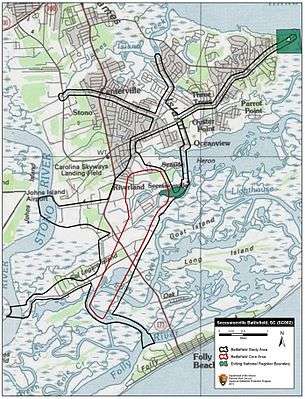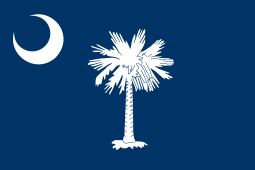Battle of Secessionville
| Battle of Secessionville | |||||||
|---|---|---|---|---|---|---|---|
| Part of the American Civil War | |||||||
 Secessionville Battlefield | |||||||
| |||||||
| Belligerents | |||||||
|
|
| ||||||
| Commanders and leaders | |||||||
| Henry Benham |
Nathan G. Evans Thomas G. Lamar | ||||||
| Units involved | |||||||
| North District, Department of the South |
2nd Military District of South Carolina Tower Battery/Fort Lamar Garrison | ||||||
| Strength | |||||||
| 6,600 | 2,000 | ||||||
| Casualties and losses | |||||||
| 685 | 204 | ||||||

The Battle of Secessionville (or the First Battle of James Island) was fought on June 16, 1862, during the American Civil War. Confederate forces defeated the Union's only attempt to capture Charleston, South Carolina, by land.
Battle
In early June 1862, Union Maj. Gen. David Hunter transported the Union divisions of Brig. Gens. Horatio G. Wright and Isaac I. Stevens, under the immediate direction of Brig. Gen. Henry Benham, to James Island, where they entrenched at Grimball's Landing near the southern flank of the Confederate defenses. Benham landed 6,500 men from the 3rd New Hampshire, 8th Michigan Infantry , 7th Connecticut Infantry, 28th Massachusetts, and 79th New York "Highlanders" on the southeastern end of James Island, and marched toward Charleston. Confederate Brig. Gen. Nathan "Shanks" Evans, who had been given command of the 3,000 Confederate defenders of James Island on June 14, barely had time to assess his new command. At about 4:30 a.m. on June 16 the Northern troops attacked the Confederate fort at Secessionville where Colonel Thomas G. Lamar commanded about 500 men who had a number of very heavy artillery guns and a good field of fire. After an intense battle, the fort's defenders, augmented during the fight by approximately 1,000 men from nearby Confederate units, prevailed.
Aftermath
The Union suffered 683 casualties (107 dead), compared to 204 (52 dead) by the Confederates. Although the battle was minor, it served as a powerful propaganda victory, increasing morale, particularly in Charleston, and offsetting recent Confederate losses in the Western Theater.
Although the numbers involved were small, the stakes were high. Benham had acted against orders in attempting to take James Island, and he was subject to a court martial after the loss. The Union continued its attempt to starve and attack Charleston for the rest of the war. Had they succeeded in taking "Fort Lamar" at Secessionville, they could have controlled the harbor.
See also
References
- Brennan, Patrick. Secessionville: Assault on Charleston. Campbell, CA: Savas Publishing Company, 1996. ISBN 1-882810-08-2.
- Foote, Shelby. The Civil War: A Narrative. Vol. 1, Fort Sumter to Perryville. New York: Random House, 1958. ISBN 0-394-49517-9.
- CWSAC Report Update
![]() This article incorporates public domain material from the National Park Service document "Battle of Secessionville".
This article incorporates public domain material from the National Park Service document "Battle of Secessionville".
External links
- Secessionville Battlefield Page: Battle maps, photos, history articles, and battlefield news (Civil War Trust)
- Re-enactment of the Battle of Secessionville
